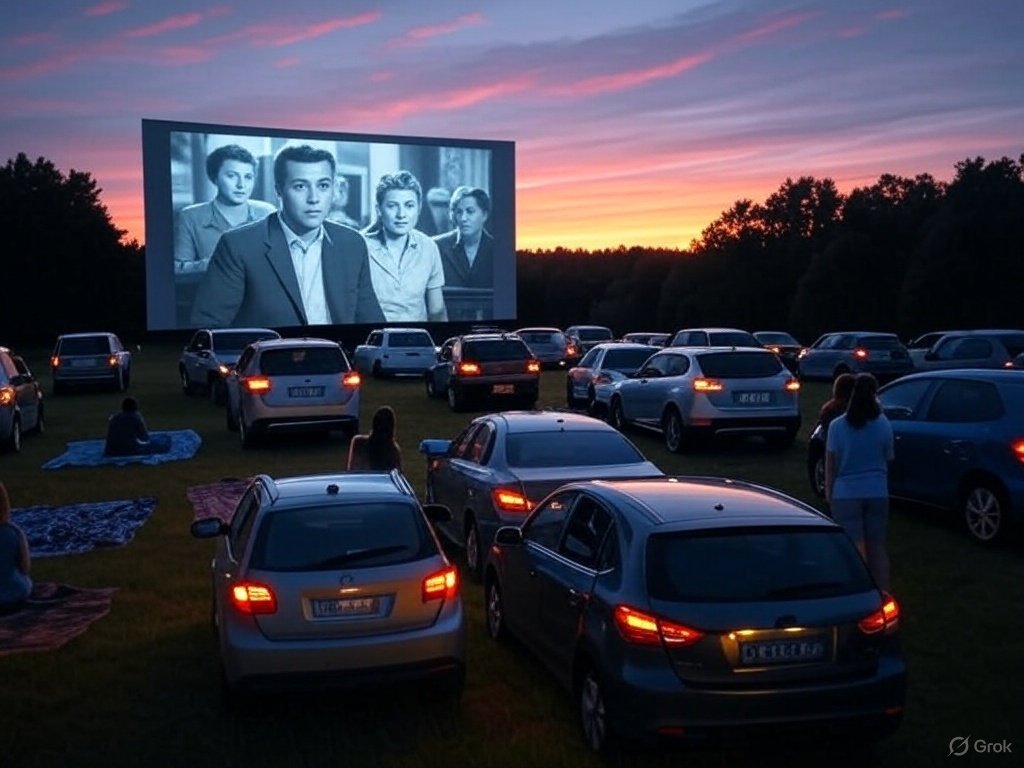There’s something undeniably magical about settling into your car seat just as the sun dips below the horizon, the sky shifting from gold to indigo, and the screen flickering to life with the roar of an opening title. In 2025, drive-in theaters—once thought a relic of mid-century Americana—are experiencing a vibrant resurgence. Fueled by consumer nostalgia, savvy operators embracing modern technology, and a desire for socially distanced entertainment, drive-ins have evolved into hybrid venues blending retro charm with gourmet concessions, themed events, and tech-forward experiences. Whether you grew up under the glow of a giant outdoor screen or are discovering drive-ins for the first time, here’s why these al fresco cinemas are more than a novelty—they’re redefining communal movie-going for a new generation.
A Storied Past Meets Contemporary Desires
Drive-ins peaked in the late 1950s, with over 4,000 locations dotting the American landscape. They offered families an affordable, relaxed way to catch the latest Hollywood releases without ever leaving their cars. But the advent of multiplexes, home video, and, later, streaming, led to a steep decline. By the early 2000s, fewer than 300 remained. Fast-forward to 2025, and attendance at the surviving drive-ins is climbing steadily—up 20 percent since 2022 according to the National Association of Drive-In Theatres. What accounts for this renewed interest?
- Nostalgia & Novelty: Millennials and Gen Z, raised on digital screens and on-demand content, crave tactile experiences that break the screen-at-home monotony. A drive-in offers an immersive throwback with zero pre-roll ads and none of the distractions of a living room binge.
- Social Distancing Comfort: Even as health concerns recede, the pandemic permanently shifted expectations. Patrons appreciate the comfort of personal space combined with communal atmosphere—a perfect balance of safety and social engagement.
- Eventization of Film: Modern drive-ins aren’t just about first-run movies. Many host curated retrospectives—Cult Classics Under the Stars or Disney Animated Double Features—making each visit feel like a unique outing rather than a routine screening.
Tech Upgrades: Bringing Drive-Ins into the 21st Century
While the basic concept remains delightfully simple—parking, tuning in your car radio, and watching the movie—today’s drive-in operators have integrated cutting-edge technology to enhance quality and convenience.
- Digital Projection & Laser Systems: Gone are the grainy 35mm days. High-lumen laser projectors now deliver crystal-clear images that rival indoor theaters, even in low-light conditions. Contrast ratios are sharper, and colors pop against the night sky.
- FM & App-Based Audio: Traditional FM radio transmission persists, but many venues now offer dedicated mobile apps. Viewers can stream high-fidelity audio directly through their phones or connect via Bluetooth to portable speakers. Apps also allow silent-movie–style subtitles and multilingual audio tracks for global audiences.
- Automated Ticketing & Parking: Prepaid QR tickets—purchased online—scan at automated gates, guiding cars to optimized viewing spots. License-plate recognition systems track repeat customers, enabling loyalty rewards, dynamic pricing, and in-app concessions orders.
- Augmented Reality Overlays: Select drive-ins experiment with AR: patrons point smartphones at the screen’s frame to unlock trivia pop-ups, behind-the-scenes clips, or themed AR photo filters—blurring lines between passive viewing and interactive engagement.
Gourmet Concessions & Themed Hospitality
Traditional drive-in snacks—hot dogs, popcorn, soda—still hold nostalgic appeal, but a gourmet revolution is underway:
- Food Trucks & Pop-Up Kitchens: Partnering with local vendors, many drive-ins host rotating food trucks offering artisanal burgers, vegan tacos, and craft pizzas. A separate ordering app lets you browse menus, place orders, and receive an alert when your meal is ready, minimizing wait times.
- Themed Menus: Double features are often accompanied by themed concessions. Screening Jurassic Park? Expect “Dino Chicken Nuggets” and “Amber Fossil” hot honey popcorn. Showing a ’90s teen classic? S’mores kits and nostalgia candy boxes transport patrons back to simpler times.
- Craft Cocktails & Local Brews: Elevated beverage programs feature in-car beverage delivery. Servers on golf carts deliver pre-ordered craft cocktails and local craft-beer flights in insulated carriers—keeping drinks cold and car interiors spill-free.
- Premium Seating Options: For those seeking extra comfort, deluxe packages include rented convertible chairs positioned outside the vehicle, complete with heated blankets in cooler months and cooling fans in summer—upgrading the drive-in date-night experience.
Themed Events: Building Community Around Popcorn
The most successful drive-ins have become community hubs, orchestrating events that extend beyond mere movie-viewing:
- Classic Car Nights: Partnering with local car clubs, drive-ins host vintage-automobile showcases before screenings. Patrons admire restored ’59 Chevys and ’67 Mustangs while DJ sets spin vinyl classics.
- Silent Disco Drive-In: On select nights, DJs broadcast dance sets via FM, and attendees step out to dance atop their hoods or beside their cars, headphones on, laser lights slicing through the darkness—a hybrid cinema-dance party.
- Outdoor Film Festivals: Regional film organizations program indie-film lineups over a weekend, often pairing screenings with Q&As (projected via split-screen) where directors join virtually or in person.
- Charity & Cause Nights: Special screenings raise funds for local nonprofits. A portion of ticket proceeds supports food banks, animal shelters, or environmental groups—reinforcing the drive-in’s role as a socially conscious community partner.
Sustainability & Environmental Impact
Modern drive-ins also address ecological concerns:
- LED Lighting & Solar Power: Parking-lot lights and concession stands run on energy-efficient LED fixtures, often powered by on-site solar installations. Some drive-ins aim for carbon-neutral operations by offsetting generator use with renewable sources.
- Compostable Serveware: Concessions now utilize compostable packaging. Popcorn tubs, hot-dog sleeves, and utensils made from sugarcane pulp or bamboo reduce landfill waste.
- Car-Pooling Incentives: To curb emissions, many venues offer discounted group rates for carpoolers, encouraging friends and families to share vehicles. EV charging stations near the entrance promote electric-car attendance.
- Grass & Gravel Hybrid Lots: Replacing vast asphalt expanses with gravel–turf hybrids improves stormwater absorption, reduces heat islands, and offers a more authentic picnic-like ambiance.
Challenges & the Road Ahead
Despite their allure, drive-ins face hurdles:
- Real Estate Pressures: Urban sprawl threatens to swallow remaining large lots. Operators often juggle land-lease renewals or conversion pressures from developers who see more lucrative uses for open acreage.
- Seasonality & Weather: Inclement weather—rain, fog, extreme cold—can dampen attendance. Some venues mitigate this with covered canopies over select rows or indoor “fallback” cinemas for unpredictable climates.
- Content Licensing Costs: As studios recognize the value of drive-ins, licensing fees for first-run titles have risen. Operators balance blockbusters with public-domain classics or indie offerings to manage budgets.
- Audience Education: Younger patrons may need guidance on fundamental protocols—tuning the radio, etiquette for honking horns as applause, and maintaining respectful noise levels during screenings.
However, industry groups report that continued investment and creative programming keep drive-ins not only viable but thriving. Partnerships with streaming services for exclusive early-window drive-in premieres hint at new collaborations bridging physical and digital exhibition.
Conclusion
In 2025, drive-in cinemas stand as a testament to entertainment’s enduring power to evolve while honoring tradition. By fusing state-of-the-art projection, gourmet hospitality, themed events, and sustainability initiatives, today’s outdoor theaters offer far more than a rear-view-mirror movie—they deliver unforgettable experiences that unite nostalgia, community, and innovation under an open sky. Whether you’re chasing the glow of a sci-fi epic, sharing popcorn with your crew, or marveling at vintage cars in the parking lot, the drive-in renaissance proves that sometimes, looking back is the best way to move forward.





